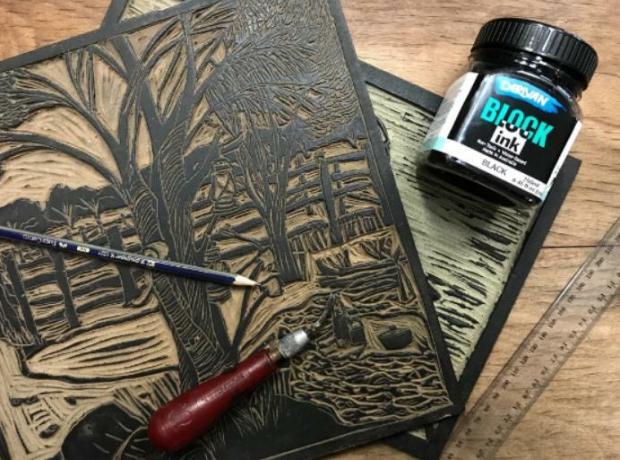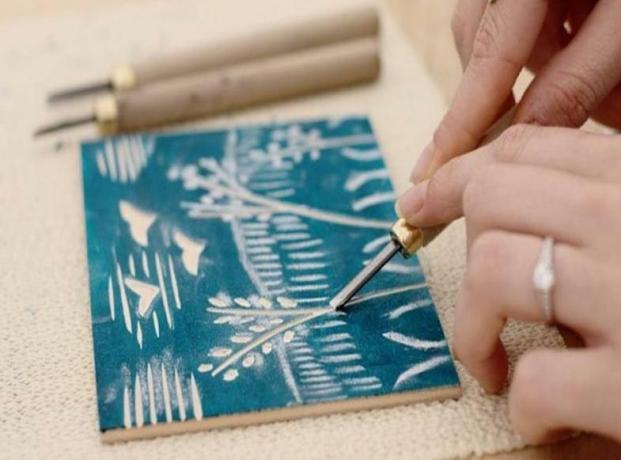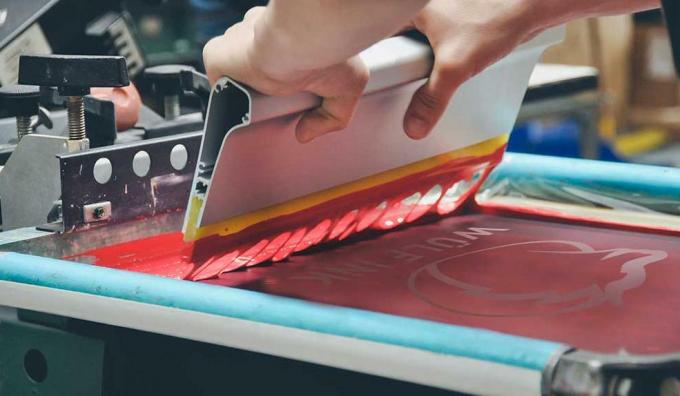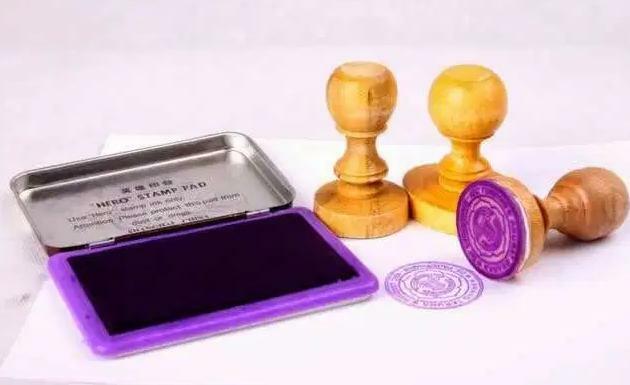Graphic Arts: Definition, Functions, Types, Examples
X
Advertisements
Loading...
There are many varieties of fine art of which one of the examples and the most famous is graphic art.
now, on this occasion, we will discuss in more detail related to graphic art, from understanding to examples.
list of contents
Definition of Graphic Art

Advertisement
1. Generally
In general, graphic art is defined as a two-dimensional work of art or commonly referred to as a graphic art “dwimatra”, which produces a variety of modern products in various media using printing or printing techniques even printing.
It can be seen that a graphic art is just a 2-dimensional image made with the aim of being enjoyed aestheticsand to beautify a medium.
The media used in this graphic art also varies, ranging from wooden boards, paper, aluminum, and anything that can be painted on it.
Graphic art can also be produced using printing techniques.
This printing technique usually uses a variety of media and equipment.
Although the printing press is a more sophisticated technology today, manual graphic printing is still being used today.
The reason, can be purely due to the aesthetic choice of an artist when choosing techniques and media.
It can also be that the manual graphic printing method is indeed more efficient than a printing press, because the printing press will only be effectively used in large-scale production such as industrial class.
2. in language
The term graphic is taken from one of the words in English, namely graf or grafhic, which means being able to write, paint, or scratch.
3. Etymologically
Etymologically, graphics come from the Greek "Graphein" which means writing or drawing.
History of Graphic Arts

At first, graphic arts developed in China.
In that country, printmaking is usually used to reproduce various religious writings. Where the religious texts are arranged/carved on a wooden plane, then printed on paper.
Various works of graphic art that use woodcut media are also commonly found in several other eastern countries, such as Korea and Japan.
The discovery of paper became one of the keys to the rapid development of this one art.
China has invented paper and mass-produced it since the year 105 under the rule of the Yi Dynasty.
The Romans were also familiar with printing techniques. They used the art to decorate their robes using stamp prints.
However, the printing technique was less developed because the Europeans were not familiar with the existence of paper.
Graphic techniques began to develop in European countries in the 13th century, with the invention of the printing press by Gutterberg, who also founded the first paper factory in Italy.
Since that time, various graphic art techniques began to develop in European countries.
In Indonesia itself, the new graphic arts existed in the 1950s. Graphic printing techniques have also begun to be widely used in applied arts to make various struggle posters.
Important figures of graphic art from Indonesia are Suromo and Abdul Salam from the city of Yogyakarta. There is also Baharudin Marasutan from Jakarta and Mochtar Apin from Bandung.
Graphic Arts Function

The following are some of the functions of graphic art that you need to know, including:
1. Adding Beauty Value
This graphic art can add value to the beauty of a medium.
If graphic art is used on a shirt or t-shirt, then the art can add beauty to the shirt.
Advertisement
Its two-dimensional nature makes this type of art able to beautify many media.
2. Expression of Art
An artist often needs a way to express artistic expression. And this graphic art can channel that artistic expression very well.
What's more, this graphic art is still a very flexible art.
3. Channeling Hobbies
For someone who likes or likes to do creative activities, in general he will channel his hobby in making graphic designs.
Because the practice of making graphic designs tends to be more interesting and easier to learn.
4. Sending Messages
This type of graphic art can also be used to convey a message to the viewer.
The message can later be embedded by the artists in an artistic incision where sometimes the message is implied.
5. Increasing income
This one function has become a commercial function and cannot be avoided.
By pursuing the world of graphic arts can indeed be a source of income that is quite interesting.
Because the design has increasingly had a fairly high selling price and especially for making it as a promotional medium / for book cover needs.
Characteristics of Graphic Arts

The following are some of the main characteristics or characteristics of graphic arts, including:
- Can be produced using print media, so it can be repeated with the same results. Thus, the results of his work do not use scratches from the hand anymore.
- Can be reproduced again, so that you get more than one work.
- The results of his work are very dependent on the type and also the media used.
- The result of graphic art is very dependent on the process / technique used when making it.
Types of Graphic Arts

The following are some types of graphic art that you need to know, including:
1. Flat Printing Technique (Lithography)
Lithography is a technique used to do this technique. Lithography is a technique invented by Alois Senefelder in 1798.
This technique is based on the chemical repulsion of oil in water. Where in the application uses a special stone media, namely limestone (limestone) to be the image medium.
This is because this type of limestone can suck ink.
The limestone used in this printing technique is limestone in the form of slabs.
The stone will later be coated with some chemical liquid, such as nitric acid, gum arabic, or Phosphoric Acid so that a chemical reaction will take place which makes the area that has been drawn receives ink lithograph.
After the chemical process of the stone takes place, lithographic ink can be applied to the surface of the stone.
The ink will only stick to the oily ink particles that have been drawn and will be rejected elsewhere.
Then the paper is pressed using a press on the limestone and will transfer the image to the paper.
There are also several world artists who use this technique, including:
- Pablo Picasso
- Emil Nolde
- and Joan Miro.
2. Screen Printing Technique (Silkscreen)
You will find this type of graphic printing quite often. Screen printing technique is also known as screen printing technique.
In the filter printing technique, you will need a screen made of screen printing. The gauze has flexible, elastic, and smooth properties.
The filter printing technique is quite popular because the method is quite easy.
There are also several world artists who use this technique, including:
- Edward Rusca
- Chuck Close
- Joseph Albert
- and Robert Indiana.
3. Deep Printing Techniques (Intaglio)
The deep printing technique is a technique for scraping the media using a blunt object.
In general, the media used in the deep printing technique is metal.
The ink will later be smeared on all the printed surfaces that have been inscribed in. Then usually the surface will be cleaned and leave only the ink on the inside of the surface.
Advertisement
After that, the slightly moistened paper will be pressed / pasted onto the printing surface.
Then then the ink will move on the paper.
Printed graphic art is divided into several sections, including:
a. Etching
This etching technique uses the help of nitric acid (HNO3). The acid liquid will later be inscribed on the copper plate.
The use of etching techniques such as carving using a liquid. In this case what is carved is a copper plate.
In ancient times, etching techniques were used to carve armor.
b. Engraving
In the engraving technique, an artist must use a tool called a burin and this tool serves to carve metal.
The surface of the metal will be painted, then the artist must engrave the metal using a burin.
Then the metal surface will be cleaned of paint and all that remains is paint on the metal parts that have been carved.
c. drypoint
The drypoint technique is a technique that uses a pointed object to engrave a medium.
The pointed object will later press the surface of the media, so that it will form a painting.
d. Mezzotint
The mezzotint technique is a technique of smooth scraping the metal surface where in this technique uses a dominant dark and light effect.
4. High Printing Technique (Woodcut)
Johanes Gutenberg is the inventor of this printing technique.
High print is one of the activities of image propagation through a printing press which consists of two parts, namely the protruding part (such as relief), the area to be printed. prints the image and is called the plate reference section and the non-image section, which is the lower area and was deliberately cut off so as not to get ink or paint.
In simple terms, the high printing technique will create a print like a stamp, which is to make a relief by picking at the material (usually wood/rubber) in order to print the desired image.
Because in the past, the material that was often used was wood. Sometimes this technique is also referred to as woodcut printing.
Nowadays, rubber (lino) has become a popular alternative because it is a soft material that makes it easier to peel off.
5. Photo Printing Techniques
Photo printing technique in graphic arts is a printing technique that you often encounter.
In the photo printing technique, you can use a camera. Then the image on the camera can be printed using a printer.
Advertisement
Photo printing techniques are often referred to as photographic techniques.
6. Stencil Printing Technique
The way the stencil technique works is a technique by cutting paper according to the desired motif. Then pasted on the print media.
After being pasted, the print media will be painted/sprayed using spray paint.
After the paint is dry, the paper will be removed so that it will leave a motif on the printed media.
7. Collagraphy Printing Techniques
The way this collography technique works is by placing a printed motif on the bottom of the paper. Then the paper is painted / shaded using a pencil.
Then the paper is removed from the mold and will produce an image object that appears and the part that is not depicted will become concave.
Graphic Art Making Tools & Materials

There are several tools and materials in making graphic art that are very commonly used, including:
1. Tool
The following are some of the types of tools used to create graphic art, namely:
- Knife
- chisel knife
- Burin
- Spikes and iron
- Screen
- Rockers
- screen printing table
- Computer
- Camera
- Printer
- High pressure press
- Rachel.
2. Ingredient
Meanwhile, the materials commonly used in making graphic arts include:
- Hardboard
- Iron
- gauze
- Metal plate
- Paperboard
- Limestone
- Oil paint
- Photo paper
- Ink
- camera film
- Film washing agent (Including caustic soda, cleaner and bleach)
- Camera memory
- Ulano
- screen printing
- Chromatin
- Afdruk material.
Graphic Art Example
After knowing the description of graphic art above, here we will give some examples of graphic art, including:
1. Banner Graphic Art Example

2. Example of Screen Printing Graphic Art

3. Poster Graphic Art Example

4. Example of Stamp Graphic Art

From the billboards on the side of the road to the shirt screen printing motifs. Even the stamp in the official document is also included in the graphic arts.
So that graphic art has become a familiar and popular art.
